A Nordic Nation Establishing its Unique Identity
FOOD
Icelandic Skyr
Icelandic Food
Food Culture
Inspired by Iceland published a series of videos showing viewers how to prepare traditional Icelandic dishes, such as Skyr. v1.
v1.
Inspired by Iceland published a series of videos showing viewers different aspects of Icelandic culture. In this video, an expert on Icelandic food talks about all of the resources that chefs have to make food and all of the available ingredients that Icelanders in general have to work with because of their climate and location. v2.
These two videos are also by Inspired by Iceland. They are part of a series called the A-Ö of Iceland. In this section, "taste," an expert in food culture talks about why Icelandic food and the culture that surrounds it is so great. In the top video, a chef explains why he loves cooking in Iceland and what some of his favorite ingredients are. These videos were published very recently, on October 22, 2018. v3.
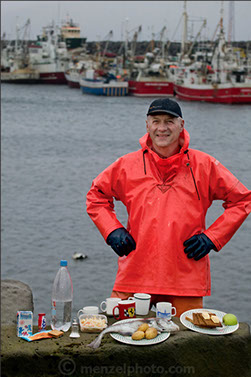
This photo comes from Peter Menzel's photo project "What I Eat: Around the World in 80 Diets." From the caption on Menzel's website: Karel Karelsson, a commercial cod fisherman, with his typical day's worth of food at his home port of Sandgerdi on the western side of Reykjanes peninsula, Iceland. i3.
"The connection between food and happiness is well documented. The good people at McDonald's know this...
people like to chew on misery, but they want to swallow happiness...so what does this say about Icelanders? Quite a lot, it turns out, for these people have some funny ideas about food" (Weiner 151). o2.
Based on what tourism sites like Inspired By Iceland and Guide to Iceland (o3) say about Icelandic cuisine, it seems like they have a lot of great sources to choose from to have some of the most fresh food in the world because of their location. Their water is extremely clean and fresh, which creates clean nature and fertile fishing grounds. Their geothermal energy makes it possible to have fresh vegetables all year, grown in greenhouses. This makes for a lot of local and available organic food. Fish is an important part of Icelanders diets, as it has been a vital component of Icelandic culture for centuries. Lamb is also a staple of Icelandic diets. Sheep roam the open countryside free range in the summer, then in the fall they are herded up for slaughter (read more about this tradition in Micalea Leaska's interview).
Inspired by Iceland recommends that visitors try Iceland's favorite snack, the pylsa, or hot dog. In Eric Weiner's book The Geography of Bliss (o2), Weiner talks about a few of the traditional Icelandic foods and drinks that he encountered while traveling, including súrir hrútspungar (ram's testicles), hakarl (rotten shark) and a drink called svarti dauoi (black death). Pickled, salted, cured, or smoked fish and meat of various kinds are quite common on Icelandic menus. In describing the flavor of harkarl, Weiner wrote, "I've never actually eaten boot polish,

This photo shows hakarl hanging out to dry. Hakral is a national dish of Iceland consisting of a shark or other sleeper shark which has been cured with a particular fermentation process and hung to dry for four to five months. Kæstur hákarl has a strong ammonia-rich smell and fishy taste. i6.
but this, I imagine, is what it tastes like," (Weiner 152). While many of the people that I interviewed agreed that fish and lamb and other native Icelandic cuisine is common and important, they also talked about a wide range of other foods. One person mentioned eating lots of Asian food and Polish pirogies, another mentioned Indian food. One interviewee even said Domino's pizza! So it seems like people enjoy traditional cuisine, but they also enjoy many other types of more "universally liked" foods.
HEALTH
The Icelandic diet directly contributes to really good health in Icelanders. In fact, Iceland is considered to be one of the healthiest places in the world. Iceland has a universal health care system that is financed by general taxation (o4). Their leading body that is responsible for the administration of health services is the Minister of Health and Social Security. According to the World Health Organization, "the most frequent cause of death in Iceland is cardiovascular diseases. At the 2013 World Health Assembly, the Icelandic delegation identified ageing, noncommunicable diseases, the health impact of climate change, and emergency preparedness as focus areas." (o4).
One notable feature of Icelandic health is their extremely clean water. It is used for everything, from washing clothes to drinking, and "it has long been thought that the natural hot water and the many minerals in it do wonders for people’s health," according to Guide to Iceland o5. They explain that "in recent years, Icelanders have also become very concerned about eating healthily, with a number of athletes promoting healthy options and the raw food chain Gló opening up a number of restaurants in Reykjavík" (Guide To Iceland, o5). Sports and outdoor recreation (hiking, horseback riding, running, etc.) are commonplace in Iceland, too.

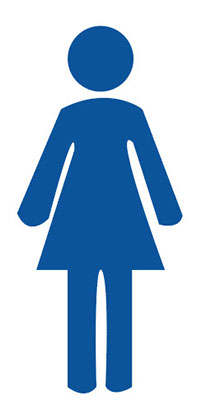
80.9
85.4
83.1
Life expectancy
Besides physical health, which can be explored more in the statistics section, Iceland also ranks really high in many categories of the OECD Better Life Index (o8), which assesses countries based on a number of different aspects of life and society to determine how healthy they are (economic, socially, mentally, etc). From the site: "Iceland performs well in many measures of well-being relative to most other countries in the Better Life Index. Iceland ranks at the top in jobs and earnings and social connections, and above the average in income and wealth, subjective well-being, health status, environmental quality, personal security, civic engagement, and education and skills. It ranks below average in housing and work-life balance."
Explore a comprehensive report on life in Iceland here (o6).
Many of my interviewees mentioned obesity as a health problem they saw in Icelandic culture. In searching through the World Health Organization's Iceland profile, I discovered that data from 2010–2011 show that 66.7% of men and 50.4% of women aged 18–80 years were overweight and the proportion of men and women that were obese was 22.7% and 19.3%, respectively (o7). See the chart below to see how Iceland compares to other countries.
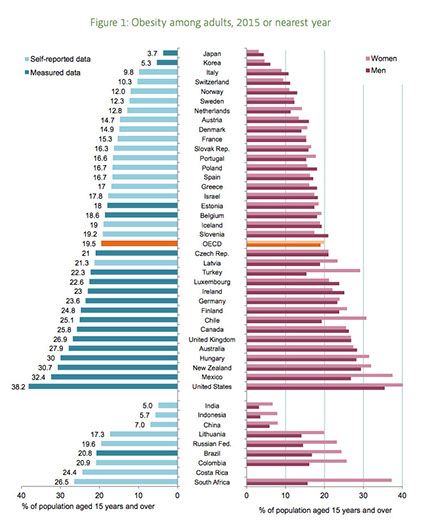

i7.
c9.
c10.
"Here was an essential truth about Icelandic happiness: it is largely a collective enterprise."
- Erin Weiner
HAPPINESS
According to the World Happiness Report 2018 (o9), Iceland is number 4 our of 156 other countries in terms of happiness (a score of (7.495). This is based on national average life evaluations in terms of six key variables: GDP per capita, social support, healthy life expectancy, freedom to make life choices, generosity, and freedom from corruption. Iceland was only beat out by Finland, Norway, and Denmark - all of which are other Nordic countries. It seems that there must be something in that Nordic air that just makes people happy. I feel like one of the best perspectives that I was able to get on the topic of happiness in Iceland was from Eric Weiner's book. In it, he explores and analyzes the potential reasons why Icelanders rank so high in statistical "happiness."
Our typical fantasies of "paradise" usually involve sunny, warm, tropical places. We associate lounging around in the brightness with happiness, whereas we often associate the cold and dark with sadness. So why, then, is Iceland so happy? They spend several months out of the year in 24-hour darkness! Perhaps it is because they are so used to this dark, cold life that they make the best of it. Iceland is really small (350,000 people), so perhaps the happiness is rooted in the tight-knit community where many people know each other or are related to one another.

Another theory I found fascinating was the idea of economic community. In Iceland, they have really low unemployment rates, but because of this they have high inflation. "High inflation is shared pain; everyone feels the pinch of higher prices when they go to the grocery store or gas station. Everyone suffers a little; no one suffers a lot" (Weiner 150). This concept of shared economic pain speaks to the values of Icelandic society; they want everyone to be well off.
Weiner also connects happiness to creativity and concludes that there is definitely a correlation between the two. Iceland, and Reykjavik specifically, is a cultural explosion that is happening right now (read more about culture in the cultural sovereignty section). Matter of fact, almost everyone there is a writer in some way, so Weiner fit right in. Maybe this explains why Icelanders value their language so much - and therefore maybe language plays into the notion of happiness. "If it is possible for language, mere words, to nurture happiness, to tickle the creative soul of an entire people, then surely that language is Icelandic," says Weiner, who proves his point even further by explaining that the formal Icelandic greeting, "komdu sæll," translates literally as "come happy." (Weiner 155-6).
This chapter goes on to talk about all of the many other aspects of Icelandic culture that contribute to general happiness, such as having many different jobs and backgrounds in one's life, not having a societal stigma around failure, being supported by others, etc. But overall, this book surely shows some of the real anthropological reasons why Iceland is so happy.
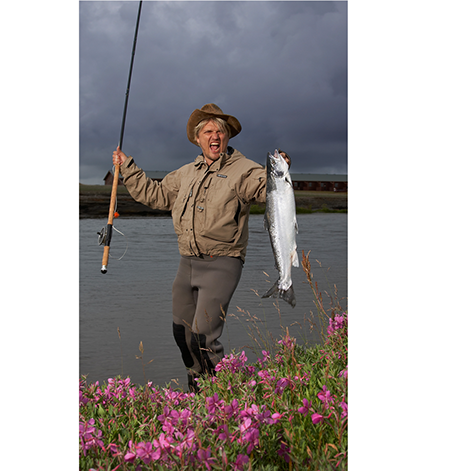
Photo of a fisher in Iceland presenting their catch. This photo was taken from the Promote Iceland media bank for travel trade. i8.
